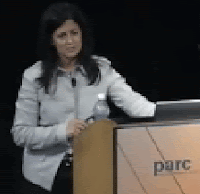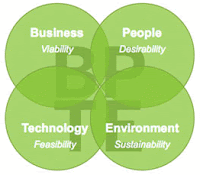 This past Thursday, I attended two presentations on "green design." Late in the afternoon, Terry Swack, Founder & CEO of Clean Culture and pictured at right, spoke at PARC on "Sustainable Product Design." Then, during the evening, frogdesign hosted a panel in San Francisco entitled, "The Many Shades of Green."
This past Thursday, I attended two presentations on "green design." Late in the afternoon, Terry Swack, Founder & CEO of Clean Culture and pictured at right, spoke at PARC on "Sustainable Product Design." Then, during the evening, frogdesign hosted a panel in San Francisco entitled, "The Many Shades of Green."As reflected in both of those presentations and their content, green design is big these days, and for very good reasons. Burning Man has even gone green this year (in a manner of speaking)!
But as Terry put it:
"Many companies are beginning to understand what they need to do, but they just don't know what's most important and where or how to begin."Hence, to borrow Terry's quote from Joel Makower's blog:
"...the pace of change seems oh-so slow" (October 2006)It is interesting that both of the above quotes are akin to what many still say in reference to experience design rather than sustainable design. Indeed, there is lots of overlap in the nature and flavor of both conversations.
Consider these additional quotes from Terry's presentation, which are also akin to what is often said about user experience:
"...(corporate social responsibility) can be much more than a cost, a constraint, or a charitable deed—it can be a source of opportunity, innovation, and competitive advantage.” (from "Strategy and Society: The Link Between competitive Advantage and Corporate Social Responsibility," December 2006)
"For change to occur, life cycle mindsets (must be) adopted and incorporated during conceptual product design stages."
 Hence, those focused on moving user experience into a position of greater corporate influence might have something to learn from those focused on moving sustainable design into a position of greater corporate influence, and vice versa.
Hence, those focused on moving user experience into a position of greater corporate influence might have something to learn from those focused on moving sustainable design into a position of greater corporate influence, and vice versa.For example, an interesting strategy initiated by frogdesign is what they call the Kyoto Treaty of design (see Valerie Casey's "The Designer's Dilemma," Summer 2007). Outlining basic tenets of "a call to arms for the creative community around environmental stewardship," this treaty has, according to Valerie, been signed by every consultancy frogdesign has approached, thus increasing the chances the principles will be followed by any consultancy a company might take their business to. This is reminiscent of Clare-Marie Karat's efforts back in 1998 at getting companies to endorse a Computer User's Bill of Rights. Might there be other applications of such a strategy?
And what about green design of user experience?
 In a paper that received the Best Paper Award at CHI 2007, Eli Blevis (pictured at right) "presents the perspective that sustainability can and should be a central focus of interaction design."
In a paper that received the Best Paper Award at CHI 2007, Eli Blevis (pictured at right) "presents the perspective that sustainability can and should be a central focus of interaction design."Jon Kolko and I, the incoming Editors-in-Chief of interactions magazine, are delighted that Eli will be contributing editor for an article on sustainable design for all issues of interactions magazine beginning in January 2008.
---
The Venn diagram is from Adam Richardson's "Tragedy of the Commons," Summer 2007.
